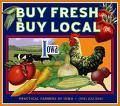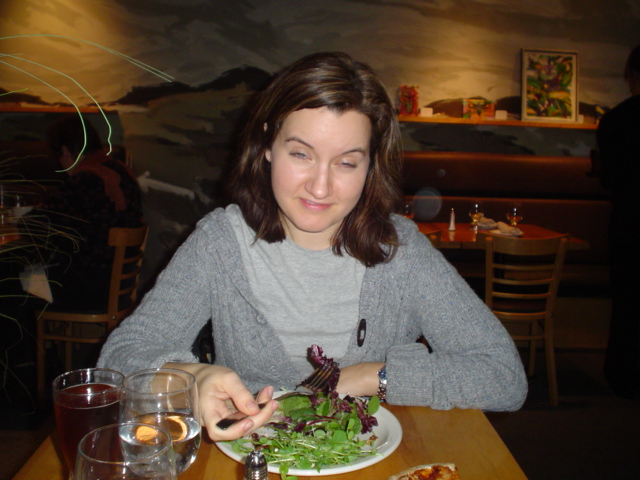 In Gourmet magazine’s TV series Diary of a Foodie, episode 15 focuses on the good molds used in developing certain foods. I recorded the show last night to find out if any food safety would be mentioned, and we watched it today while eating Doug’s homemade baguettes and some mold-covered camembert made in the U.S. with pasteurized milk.
In Gourmet magazine’s TV series Diary of a Foodie, episode 15 focuses on the good molds used in developing certain foods. I recorded the show last night to find out if any food safety would be mentioned, and we watched it today while eating Doug’s homemade baguettes and some mold-covered camembert made in the U.S. with pasteurized milk.
Narrator: “The smell of rot – that ripe funk of a humid cellar – is heaven to any cheese affineur.” (Affinage is the process of aging or ripening of cheese).
Taking us to the Parisian cheese shop of famed fromagère Marie-Anne Cantin, the first host says, “Mold is like alchemy in food.” It changes food “magically.” Yes, mold is good for a lot of things. It does participate in some magical cheese making. Cantin explains the varieties of penicillium and how they are introduced to a different cheeses. The host says that mold protects the cheese so “bad things don’t get into it. So it’s actually good for you.”
This is all fascinating, but the safety of it is not addressed. Instead the show focuses on issues of taste and legality. In the U.S. raw milk cheeses have to be aged at least 60 days, because, as Cantin says in untranslated French, “Americans are a little afraid.” The host comforts the viewers saying that serious foodies are trying to change this law.
The show goes on to explore the Botrytis grape mold used in making great Sauterne and other dessert wines, homemade yogurt made from a 19th century culture at the Schimmel Bakery (Narrator: “Edible bacteria adds delicious pungent flavor and some are quite simply good for you”), how rotten potatoes can be used to make bread with the “most old-fashioned flavor,” and … rotten corn.
Narrator: “While some will scream ‘health risk’ at the sight of huitlacoché’s mushrooming black spores, in Mexico these infected corn kernels are considered a delicacy.”
At Santa Monica’s Border Grill, huitlacoché it’s used in quesadillas for the “adventurous” crowd. Huitlachoché is the mold growing on corn kernels. The kernels blow up into a mushrooms that are cut off the cob, chopped up, and cooked. The chefs say it’s sweet and smoky tasting. According to one of the chef’s theories, “The more different things you eat, the healthier you’ll be.”
The only food safety advice comes across quite casually towards the end of the show in another cheese and sausage shop that tries to import foods unknown in the U.S. White fluffy mold on the sausage is OK, green or black mold on air-dried beef is bad.
Anyway – mold is everywhere. “It’s natural,” says Cantin.
Mold may be natural, but some of it, can make you sick. Mycotoxins, poisonous toxins that can make you sick, grow on grain, nuts, celery, grape juice, apples, and other produce. Aflotoxin, a type of mycotoxin that can grow on peanuts and corn, is cancer causing. According to the USDA website, “The U.S. Food and Drug Administration and the USDA monitor peanuts and field corn for aflatoxin and can remove any food or feed with unacceptable levels of it.”
Molds can cause allergic and respiratory problems, and the USDA advises not to buy moldy foods, “Examine food well before you buy it. Check food in glass jars, look at the stem areas on fresh produce, and avoid bruised produce. Notify the store manager about mold on foods!” The USDA site http://www.fsis.usda.gov/Fact_Sheets/Molds_On_Food/index.asp has an excellent chart about which foods, when moldy, should be discarded and which can be spared. It also explains why.
In addition, Louisiana State University advises, “Mushrooms in lawns and moldy foods can be health hazards for your dogs, according to LSU AgCenter veterinarian Dr. Steve Nicholson.”
It’s safest to know your molds, the good and the bad, as well as their associated risks before you eat them or feed them to your children or dogs.
.jpg) While many cities grapple with the desirability of restaurant inspection disclosure, a new City of Milwaukee Web site is offering the first-of-its-kind digital system that enables visitors to review health inspection records of city restaurants, food stores and other outlets that sell food.
While many cities grapple with the desirability of restaurant inspection disclosure, a new City of Milwaukee Web site is offering the first-of-its-kind digital system that enables visitors to review health inspection records of city restaurants, food stores and other outlets that sell food.
 Denver
Denver
 The
The  Trying to include considerations of microbial food safety — the things that make people barf — when encountering the dogma of fervent foodies is an occupational hazard. Over the years I’ve been slandered, threatened with lawsuits and harm to my person. Taking on the natural-organic-local cabal — including the Food Network which didn’t like our
Trying to include considerations of microbial food safety — the things that make people barf — when encountering the dogma of fervent foodies is an occupational hazard. Over the years I’ve been slandered, threatened with lawsuits and harm to my person. Taking on the natural-organic-local cabal — including the Food Network which didn’t like our  Food safety has made it to
Food safety has made it to  In Gourmet magazine’s TV series
In Gourmet magazine’s TV series  The
The  Michael Doyle, food safety expert with the Institute of Food Technologists and director of Center for Food Safety at the University of Georgia, told the
Michael Doyle, food safety expert with the Institute of Food Technologists and director of Center for Food Safety at the University of Georgia, told the